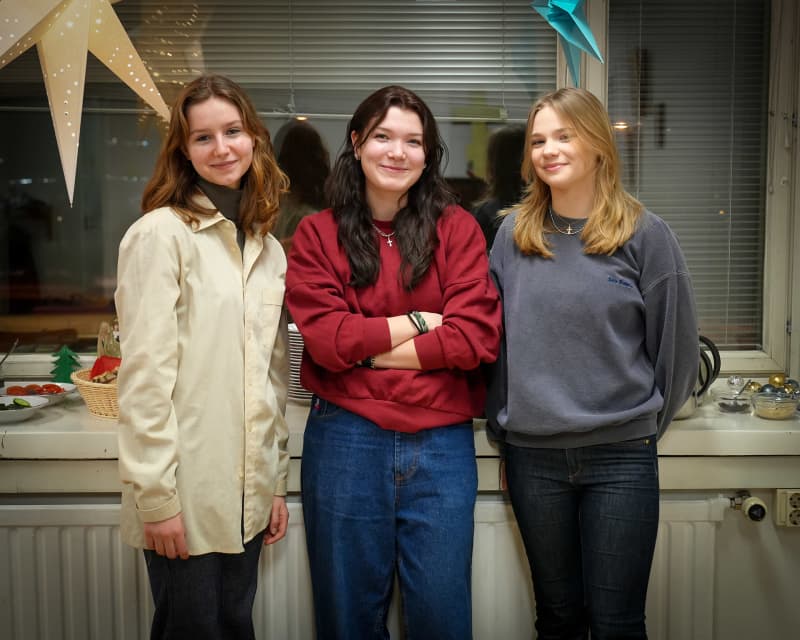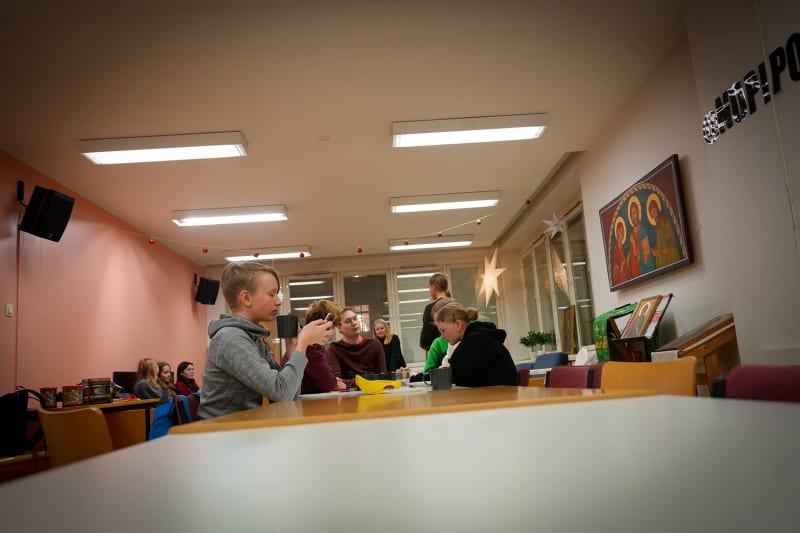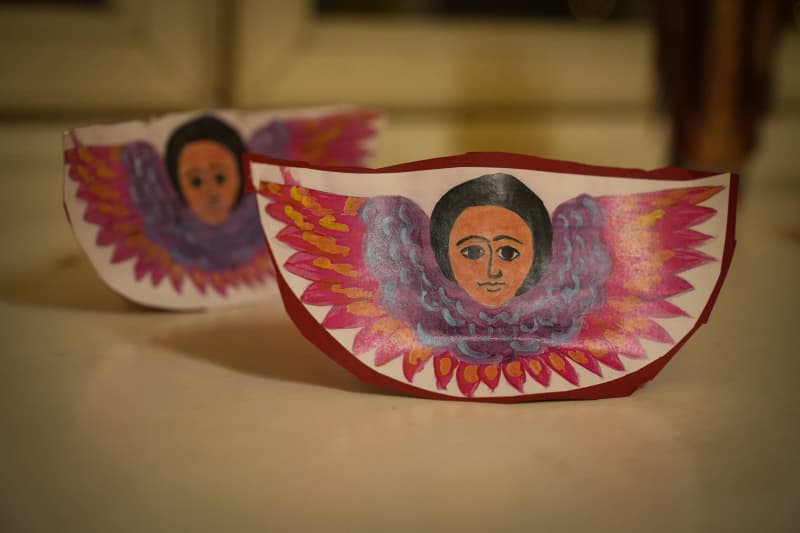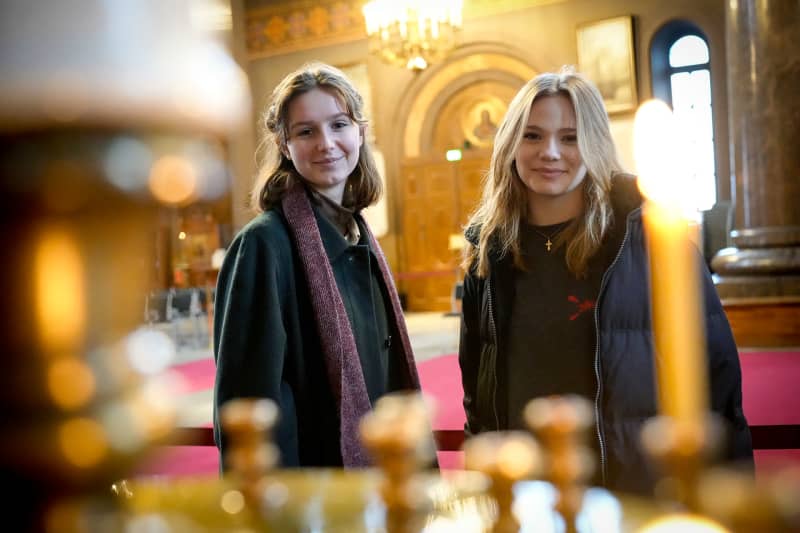
We asked how the religion of the three Orthodox nuns is reflected in their daily lives as the world around them is in turmoil. The most important time of the year for Orthodox Christians is about to begin.
– Russia is currently violating everything that belongs to the Orthodox community. The idea of Orthodoxy no longer exists in Russia, even though the external characteristics of the religion are the same,” Parsama sums up.
– There is much more to church than worshipping a cause. Church is more about discussion, philosophy and ethics, or reflection on what is right and what is wrong,” Parsama continues the same theme.
Orthodoxy is part of identity
The Youth Circle of the Helsinki Orthodox parish has gathered on Tuesday evening in Unioninkatu. The meeting room, decorated with icons, has a relaxed and cheerful atmosphere. There are snacks on offer: coffee, buns and lots of different coloured loose sweets. The group of young people is lively, playing games and taking a few selfies.
At best, four to fifty young people are present.
– Here we meet friends, talk and exchange news. We really like coming here, this is a safe place and you can have an open conversation with anyone here, Aivi Vesterinen, Katja Veselova and Lilja Parsama say in unison.
For Vesterinen, Veselova and Parsama, orthodoxy means a way of life.
– Orthodoxy is an essential part of my identity and I have always experienced it as a special and important thing for me, Vesterinen sums up.
On the other hand, Orthodox identity is not necessarily built right away and only from that. Katja Veselova has lived in Vantaa, where there have hardly been any other Orthodox.
– In addition, two other students could be involved in the religion lessons. At one point, I was perhaps a bit bitter about being Orthodox: I sometimes felt lonely. After Kripar, however, I have been satisfied. I have been able to practice my religion and I am really happy that I am Orthodox.
Kripari, or Christian school, is an important milestone in the life of Orthodox youth. The week-long camp is compared to the seminary school of the Evangelical Lutheran Church, that is, the young people get to know their own religion there and make new friends at the same time.
– The parish also has an Instagram account, where you can post a picture of your namesake saint and write a small essay about him next to it, Aivi Vesterinen says.
The world is changing, but orthodoxy is not
The word orthodox means orthodoxy and a correct understanding of tradition. Traditions are of great importance in religion, and it is also visible in the lives of Orthodox youth.
– The world changes, but it’s also nice to think that something remains unchanged and is connected to traditions. For example, Orthodox worship has remained the same for hundreds of years, says Katja Veselova.
On the other hand, in some matters, the Orthodox religion could be a little more relaxed: Veselova, Vesteri and Parsama are considered examples of same-sex marriages and female priesthood.
– There are indeed priests in the church who have nothing against such things as such, but they still want to respect ancient traditions, Veselova continues.
Easter the most important holiday
Holidays, the most important of which is Easter, are an essential part of traditions, including for young people. You can get into the Easter mood with, among other things, festive dishes such as kulitsa and Pasha (\”*super good!*\”).
– Yes, and that Easter feeling comes precisely from the fact that Pasha is made yourself and not bought in a store, Aivi Vesterinen emphasizes.
Orthodox Easter includes several customs, one of which is related to the egg: painting the egg and breaking the shell symbolizes the risen Christ and new life. However, the custom is a bit modernized, and the egg has been lost in the shuffle of history.
– After the service, we have gone to eat with the whole family and got a chocolate egg that says Christ rose from the dead. I don’t really think that today’s children would be excited if they got an egg instead of a chocolate egg, says Katja Veselova.
*Christ rose from the dead, truly rose* is the traditional Easter greeting of the Orthodox.
– It is taken care of at home in families many times and it makes you feel really powerful, Aivi Vesterinen says.
Along with the chocolate egg, a few other things have been modernized, and fasting, for example, has gained a wider meaning.
– It can be, for example, a candy or cell phone fast and generally reducing certain things. I don’t eat red meat at all, and during Lent my whole family has tried to be part of it. My brother, on the other hand, has tried gaming fasting, Lilja Parsama says.

Church members are disappearing, but the number of Orthodox is growing
The Orthodox Church of Finland currently has approximately 57,000 members. However, the number of members has been decreasing: more than a thousand people left the church last year. The church considers one of the reasons for the decline in the number of members to be that people in general no longer want to commit to institutions.
Although the number of church members has decreased, the number of Orthodox in Finland is increasing, especially with immigration. Currently, the number is increased by Ukrainian refugees.
As an autonomous church, the Finnish Orthodox Church belongs to the Ecumenical Patriarchate of Constantinople, while the Russian Orthodox belong to the Moscow Patriarchate. The Finnish Orthodox Church separated from Moscow already in 1921, and two years later it received autonomy from the Ecumenical Patriarchate of Constantinople. This year is therefore a jubilee year: one hundred years as part of the Ecumenical Patriarchate.
In the Uspensky Cathedral, the largest Orthodox church in Western Europe, completed in 1868, war, human evil and worldly worries seem like very distant things. Huge granite pillars rise to heights and the air is filled with the smell of beeswax.
– You get a proud feeling, because everything in the cathedral is so beautiful and carefully thought out. There is no such atmosphere in the Helsinki Cathedral: an altar of a thousand icons, the lighting of candles or incense, says Lilja Parsama.
– I get a good and safe feeling. That now you have come to the right place, Aivi Vesterinen adds.




